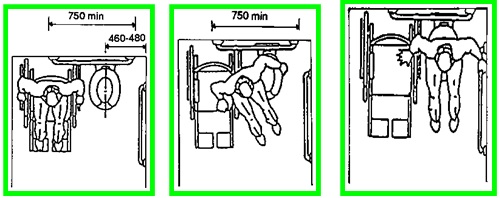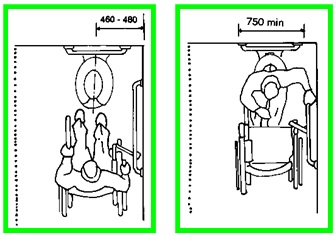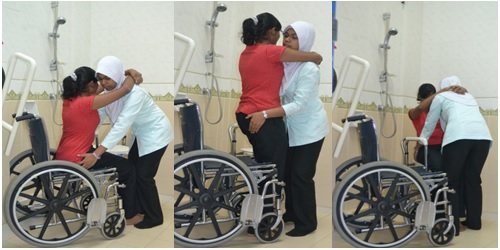Introduction
Mobility and transfer are important in daily life. These activities involve especially when a handicapped person is moving from a place to another so that the individual can achieve maximum independent level. The examples of activities are bathing, toileting, going in/out of the car and others. The techniques are essential to carry on the mobility and transfer activities in daily life. Therefore, for those who are suffering physical disabilities need to learn all mobility and transfer techniques so that daily activities can be done independently.
Ambulation and transfer techniques are divided into 2 that are:
-
Independent ambulation and transfer
-
Assisted ambulation and transfer
Lifting Technique Principle
To avoid from accidents during transferring, some principles should be obeyed. The principles are:
-
The floor should be even and stable.
-
Brake (wheelchair) must be in good condition before transferring process begins. Wheelchair should be locked for safety.
-
One of the armrest and also footrest supposed to be folded so that transferring process is easier.
-
Therapist should give clear and easy to understand explanations to patient and family members.
-
Test patient’s stability to prevent accidents during transferring.
-
Show them how to use body weight as momentum in making transfer technique easier.
Independent Ambulation and Transfer
There are 4 transfer techniques that are normally used in daily life.
-
Corner Transfer
-
Place the wheelchair and toilet bowl close together.
-
Fold one of the armrest and slightly move forward with stronger leg at the back.
-
Hold arm rest with a hand and put another hand at the end of the toilet bowl.
-
It is better for patients with weak lower abdomen to transfer their body first and then the legs.
-
-
Side Transfer
-
Place the toilet and wheelchair next to each other.
-
Fold one of the arm rest (nearer to the toilet).
-
Move toward the wheelchair slightly from the toilet and hold the end of the toilet.
-
Move the hip from the toilet to the wheelchair and adjust the position to make it comfortable
-
 |
| Figure 1. 1: Side-to-side transfer |
-
Sliding Board Transfer
This transfer method is suitable when there is blockage or uneven surface.
-
Place wheelchair and toilet next to each other.
-
Fold one of the arm rests (nearer to the toilet).
-
Put sliding board in between the wheelchair and toilet. Then, move slightly forward.
-
Slide through the sliding board with hands holding the toilet.
-
When all steps above are done, adjust the legs and remove the sliding board.
-
Adjust the body’s position to it comfortable and balance.
 |
| Figure 1. 2: Sliding board transfer |
-
This method is suitable for narrow area.
-
Put the chair and wheelchair opposite to each other. Wheelchair should be at the right/left a little. Fold both foot rests to make transfer process easier.
-
Move slightly forward (patient) and then locate the wheelchair closer to the chair. Grab tightly the grab bar with a hand while the other hand holds the wheelchair. Use the hands’ strength to transfer the body from the wheelchair to the chair.
-
Adjust the legs and balance the body.
-
 |
| Figure 1. 3: Front transfer |
Assisted Ambulation and Transfer
This technique is for a weak and dependent patient for transfer activity and needs help from the guardian.
Lifting Technique Principle
This technique is for patient who needs the guardian to use lots of energy during transferring the patient. The techniques used are the same but the guardian needs one or two more assistants to help.
-
Guardian must explain to the assistants on how the lifting techniques work and the explanations must be clear.
-
Before starting the lifting process, the guardian must tell the patient to:
-
Keep calm
-
Trust the assistants
-
Do not against them while they are doing their job
-
-
Patient must facing to the front
-
Keep the patient in the correct position whether in sitting or lying down position.
Pelvic Hold Technique
-
Patient must be ready to be transferred. He/she needs to move a little bit to the front, bend towards assistant and put the stronger leg to the front a bit.
-
Assistant has to stand in front of the patient and bend the knees towards the patient. ‘Lock’ the patient’s legs to prevent him/her from falling.
-
When the patient is ready, assistant has to put both hands at the back of patient’s tights while the patient needs to hold the back of assistant.
-
To make the lifting process easier, patient must be ready and listen to the assistant all the time. When the patient has stood with support from the assistant, the patient can be transferred to another chair/place.
 |
| Figure 2.1: Pelvic hold technique |
Patient’s conditions
Ambulation and transfer techniques are suitable for several conditions of patient. The conditions are:
-
Stroke
-
Spinal cord injury
-
Head injury
-
Nerve and muscle disorder
-
Inflammation of the joint (chronic osteoarthritis of knee joint, hip joint)
-
Elderly (physical disabilities)
-
Polio disease
-
Spinal bifida
-
Others (foot amputation)
Conclusion
In conclusion, the above techniques can be used and modified according to the patient’s physical abilities, surroundings and the condition of the place.
References
-
Occupational Therapy and Physical Dysfunction Fourth edition, Churchill Livingstone, Mobility Skills (page 225-241)
-
PEDRETTI’S OCCUPATIONAL THERAPY Practice Skills for Physical Dysfunction Sixth edition, MOSBY ELSEVIER, Occupational Performance and the Performance Areas: Evaluation and Intervention; toilet transfer (page 222-223)
-
STROKE REHABILIATION A Function-Based Approached Third Edition, MOSBY ELSEVIER, Chapter 14; Functional Mobility (page366-375)
-
Kecederaan Kepala Utama |AFLAHLIFE Aflahlife.wordpress.com
-
Stroke and Its Rehabilitation Sidney Licht, Sidney Herman Licht -1975- Snipped view (page 997)
-
Occupational Therapy and Stroke Judi Edmans -2011- preview
-
Rehabilitation of The Physical Disable Adult C. John Goodwill, M. Anne Chamberlain -1988- preview (page 393)
-
Activities of Daily Living for Physical Rehabilitation Edith Buchwald Cawton -1963- Snipped view
| Last Review | : | 28 August 2020 |
| Writer | : | Abdul Gani bin Salwi |
| Accreditor | : | Zuraidah Binti Ramli |
| Reviewer | : | Tan Foo Lan |







